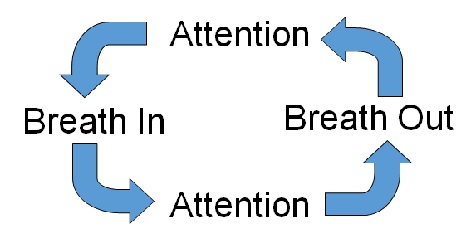Let us look at the characteristics of ordinary breathing:
- Slow breathing is volitional. It can only happen with our volition and attention when we want to do it and as long as we want to do it. Figure 1 graphically depicts its volitional nature.

Figure 1 graphically depicts the nature of slow breathing. We can make it happen with our attention. It does happen autonomically. We need to attend to every inhalation and every exhalation for it to happen.
- Slow breathing is run by our conscious mind mediating the normal flow of nature.
-
Rate of slow breathing varies with the application of our effort and attention.
-
Slow breathing is also deep breathing. Slower the breathing rate, higher the volume of air per breath.
-
In slow breathing, we consciously determine the homeostatic set points for inhalation and exhalation.
-
The homeostatic set points for inhalation and exhalation are determined by a combination of our conscious effort, our attention, the current neural circuitry of our brain and the instantaneous state of our emotions.
-
Our state of emotions keeps changing from moment to moment affecting the rate of our breathing.
-
Our neural circuitry changes from time to time with changes in our hormonal chemistry. This also changes the rate at which we can breathe.
-
Slow and deep breathing is quality breathing and it leads to quality lives.
-
Slow and deep breathing focuses our mind helping us in our contemplative practices by deepening our meditation.
-
Slow and deep breathing is an option we should exercise regularly in the interest of our health and wellness.